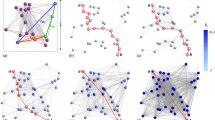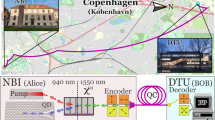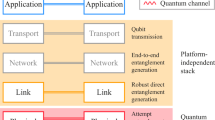Abstract
To fully exploit the potential of quantum technologies, quantum networks are needed to link different systems, enhancing applications in computing, cryptography and metrology. Central to these networks are quantum relays that can facilitate long-distance entanglement distribution and quantum communication. In this work, we present a modular and scalable quantum relay architecture using a high-quality single-photon source. The proposed network incorporates three untrusted intermediate nodes and is capable of a repetition rate of 304.52 MHz. We use a measurement-device-independent protocol to demonstrate secure key establishment over fibres covering up to 300 km. This study highlights the potential of single-photon sources in quantum relays to enhance information transmission, expand network coverage and improve deployment flexibility, with promising applications in future quantum networks.
This is a preview of subscription content, access via your institution
Access options
Access Nature and 54 other Nature Portfolio journals
Get Nature+, our best-value online-access subscription
$32.99 / 30 days
cancel any time
Subscribe to this journal
Receive 12 print issues and online access
$259.00 per year
only $21.58 per issue
Buy this article
- Purchase on SpringerLink
- Instant access to full article PDF
Prices may be subject to local taxes which are calculated during checkout





Similar content being viewed by others
Data availability
All data are available from the corresponding authors upon reasonable request. Source data are provided with this paper.
Code availability
The code for simulating the key rate is available from the corresponding authors upon reasonable request.
References
Shor, P. W. Algorithms for quantum computation: discrete logarithms and factoring. In Proc. 35th Annual Symposium on Foundations of Computer Science 124–134 (IEEE, 1994).
Grover, L. K. A fast quantum mechanical algorithm for database search. In Proc. 28th Annual ACM Symposium on Theory of Computing 212–219 (ACM, 1996).
Bennett, C. H. & Brassard, G. Quantum cryptography: public key distribution and coin tossing. In Proc. IEEE International Conference on Computers, Systems and Signal Processing 175–179 (IEEE, 1984).
Ekert, A. K. Quantum cryptography based on Bell’s theorem. Phys. Rev. Lett. 67, 661 (1991).
Giovannetti, V., Lloyd, S. & Maccone, L. Quantum-enhanced measurements: beating the standard quantum limit. Science 306, 1330–1336 (2004).
Giovannetti, V., Lloyd, S. & Maccone, L. Advances in quantum metrology. Nat. Photon. 5, 222–229 (2011).
Chen, Y.-A. et al. An integrated space-to-ground quantum communication network over 4,600 kilometres. Nature 589, 214–219 (2021).
Peev, M. et al. The SECOQC quantum key distribution network in Vienna. New J. Phys. 11, 075001 (2009).
Sasaki, M. et al. Field test of quantum key distribution in the Tokyo QKD network. Opt. Express 19, 10387–10409 (2011).
Simon, C. Towards a global quantum network. Nat. Photon. 11, 678–680 (2017).
Van Meter, R. & Devitt, S. J. The path to scalable distributed quantum computing. Computer 49, 31–42 (2016).
Broadbent, A., Fitzsimons, J. & Kashefi, E. Universal blind quantum computation. In 2009 50th Annual IEEE Symposium on Foundations of Computer Science 517–526 (IEEE, 2009).
Briegel, H.-J., Dür, W., Cirac, J. I. & Zoller, P. Quantum repeaters: the role of imperfect local operations in quantum communication. Phys. Rev. Lett. 81, 5932 (1998).
Duan, L.-M., Lukin, M., Cirac, J. I. & Zoller, P. Long-distance quantum communication with atomic ensembles and linear optics. Nature 414, 413–418 (2001).
Jacobs, B. C., Pittman, T. B. & Franson, J. D. Quantum relays and noise suppression using linear optics. Phys. Rev. A 66, 052307 (2002).
Waks, E., Zeevi, A. & Yamamoto, Y. Security of quantum key distribution with entangled photons against individual attacks. Phys. Rev. A 65, 052310 (2002).
de Riedmatten, H. et al. Long distance quantum teleportation in a quantum relay configuration. Phys. Rev. Lett. 92, 047904 (2004).
Collins, D., Gisin, N. & De Riedmatten, H. Quantum relays for long distance quantum cryptography. J. Mod. Opt. 52, 735–753 (2005).
Jing, B. et al. Entanglement of three quantum memories via interference of three single photons. Nat. Photon. 13, 210–213 (2019).
Yu, Y. et al. Entanglement of two quantum memories via fibres over dozens of kilometres. Nature 578, 240–245 (2020).
Pompili, M. et al. Realization of a multinode quantum network of remote solid-state qubits. Science 372, 259–264 (2021).
Hermans, S. et al. Qubit teleportation between non-neighbouring nodes in a quantum network. Nature 605, 663–668 (2022).
Liu, J.-L. et al. Creation of memory–memory entanglement in a metropolitan quantum network. Nature 629, 579–585 (2024).
Lucamarini, M., Yuan, Z., Dynes, J. & Shields, A. Overcoming the rate–distance limit of quantum key distribution without quantum repeaters. Nature 557, 400–403 (2018).
Ma, X., Zeng, P. & Zhou, H. Phase-matching quantum key distribution. Phys. Rev. X 8, 031043 (2018).
Hwang, W.-Y. Quantum key distribution with high loss: toward global secure communication. Phys. Rev. Lett. 91, 057901 (2003).
Lo, H.-K., Ma, X. & Chen, K. Decoy state quantum key distribution. Phys. Rev. Lett. 94, 230504 (2005).
Wang, X.-B. Beating the photon-number-splitting attack in practical quantum cryptography. Phys. Rev. Lett. 94, 230503 (2005).
Lo, H.-K. & Chau, H. F. Unconditional security of quantum key distribution over arbitrarily long distances. Science 283, 2050–2056 (1999).
Kurtsiefer, C., Mayer, S., Zarda, P. & Weinfurter, H. Stable solid-state source of single photons. Phys. Rev. Lett. 85, 290 (2000).
Aharonovich, I., Englund, D. & Toth, M. Solid-state single-photon emitters. Nat. Photon. 10, 631–641 (2016).
Keller, M., Lange, B., Hayasaka, K., Lange, W. & Walther, H. Continuous generation of single photons with controlled waveform in an ion-trap cavity system. Nature 431, 1075–1078 (2004).
Michler, P. et al. A quantum dot single-photon turnstile device. Science 290, 2282–2285 (2000).
Ding, X. et al. On-demand single photons with high extraction efficiency and near-unity indistinguishability from a resonantly driven quantum dot in a micropillar. Phys. Rev. Lett. 116, 020401 (2016).
Ding, X. High-efficiency single-photon source above the loss-tolerant threshold for efficient linear optical quantum computing. Nat. Photon. 19, 387–391 (2025).
Chou, C. W., Polyakov, S. V., Kuzmich, A. & Kimble, H. J. Single-photon generation from stored excitation in an atomic ensemble. Phys. Rev. Lett. 92, 213601 (2004).
Ripka, F., Kübler, H., Löw, R. & Pfau, T. A room-temperature single-photon source based on strongly interacting Rydberg atoms. Science 362, 446–449 (2018).
Zeng, P., Wu, W. & Ma, X. Symmetry-protected privacy: beating the rate-distance linear bound over a noisy channel. Phys. Rev. Appl. 13, 064013 (2020).
Acknowledgements
This work was supported by the Innovation Program for Quantum Science and Technology (grant numbers 2021ZD0300702 to T.-Y.C., 2021ZD0301300-1 to T.-Y.C., 2021ZD0300804 to X.M., 2021ZD0301400 to Y.-M.H., 2021ZD0300204 to Y.-H.H., 2021ZD0300800 to Q.Z., X.-P.X. and M.-Y.Z.), the National Natural Science Foundation of China (grant numbers 12174216 to X.M., 12022402 to Y.-M.H. and 62474168 to Y.-H.H.), the Anhui Initiative in Quantum Information Technologies (grant number AHY060000 to C.-Y.L.), the Shanghai Municipal Science and Technology Major Project (grant number 2019SHZDZX01 to C.-Y.L. and Y.-H.H.), the Chinese Academy of Sciences (CAS) Project for Young Scientists in Basic Research (grant number YSBR-112 to Y.-H.H.), the Youth Innovation Promotion Association of CAS (grant number Y2023128 to Y.-M.H.), the Independent Deployment Project of HFNL (grant number ZB2025010300 to Y.-M.H.), the Strategic Priority Research Program of CAS (grant number XDA0520401 to Y.-M.H.), the China Postdoctoral Science Foundation (grant number 2022T150628 to X.D.) and the Postdoctoral Research Project in Anhui Province (grant number 2024C890 to X.Y.). C.-Y.L. acknowledges support from the New Cornerstone Science Foundation. T.-Y.C. acknowledges support from the Anhui Initiative in Quantum Information Technologies.
Author information
Authors and Affiliations
Contributions
T.-Y.C., X.M. and J.-W.P. conceived the research. M.Z., Y.-M.H., T.-Y.C., Y.H., X.M., C.-Y.L. and J.-W.P. designed the experiment. M.Z. and Y.-M.H. carried out the experiment and performed data post-processing. Y.H. and X.M. performed the protocol security analysis and data post-processing. Y.H., Y.-M.H. and B.-C.L. performed a theoretical interference analysis. J.-Y.Z., R.-Z.L. and Y.-H.H. grew and fabricated the quantum dot samples. Y.-P.G., X.D., G.-Y.Z., H.W. and C.-Y.L. contributed to the generation of single-photon sources. M.-C.X. and Z.N. fabricated the cavity mirror. X.Y., M.-Y.Z., X.-P.X. and Q.Z. contributed to fluorescence upconversion. W.-X.P. and H.-T.Z. assisted with the experiment scheme discussion. D.Q. and X.J. developed the polyimide circuit board and maintained it for frequency locking. Y.H., X.M., M.Z., Y.-M.H., T.-Y.C., C.-Y.L. and J.-W.P. co-wrote the paper, with input from the other authors. All authors discussed the results and proofread the paper. J.-W.P. supervised the project.
Corresponding authors
Ethics declarations
Competing interests
The authors declare no competing interests.
Peer review
Peer review information
Nature Physics thanks Paul Hilaire and the other, anonymous, reviewer(s) for their contribution to the peer review of this work.
Additional information
Publisher’s note Springer Nature remains neutral with regard to jurisdictional claims in published maps and institutional affiliations.
Supplementary information
Supplementary Information
Supplementary Figs. 1–12, Table 1, simulation and discussion.
Source data
Source Data Fig. 1
Vector graphic.
Source Data Fig. 2
Vector graphic.
Source Data Fig. 3
Statistical source data.
Source Data Fig. 4
Simulation source data.
Source Data Fig. 5
Vector graphic.
Rights and permissions
Springer Nature or its licensor (e.g. a society or other partner) holds exclusive rights to this article under a publishing agreement with the author(s) or other rightsholder(s); author self-archiving of the accepted manuscript version of this article is solely governed by the terms of such publishing agreement and applicable law.
About this article
Cite this article
Zou, M., He, YM., Huang, Y. et al. Realization of an untrusted intermediate relay architecture using a quantum dot single-photon source. Nat. Phys. (2025). https://doi.org/10.1038/s41567-025-03005-5
Received:
Accepted:
Published:
DOI: https://doi.org/10.1038/s41567-025-03005-5



